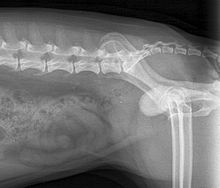Technology in veterinary medicine
This article includes a list of general references, but it lacks sufficient corresponding inline citations. (July 2017) |
Many of the technologies used in human medicine are also used in the veterinary field, although often in slightly different ways. Veterinarians use a variety of technologies for diagnostic and therapeutic purposes to better understand and improve the health of their animal patients. Recent trends in veterinary technology have moved towards the integration of hand-held devices and consumer based technology to monitor pets and interact with veterinarians.
General tools
[edit]| Thermometer | The electronic thermometer is most commonly used in veterinary practice for both large and small animals. Typically temperatures are taken rectally |
| Stethoscope | In veterinary medicine the acoustic stethoscope has a variety of uses, including auscultating the heart and lungs and listening to gut sounds. Different ear pieces and lumens may be employed according to the function |
| Laryngoscope |  Before laryngoscopes are used, the correct sized blades must be determined as they come in a variety of sizes.[2] |
| Centrifuge | A centrifuge is commonly used in veterinary practices in order to prepare blood samples for analysis. Components of the blood are separated using high velocities and centrifugal force |
| Autoclave | A machine that uses high pressures and temperatures to sterilize surgical equipment. Prior to autoclaving surgical instruments are cleaned and may be sorted and grouped by surgical procedure |
| Glucometer | A tool used to approximate blood glucose levels, often in order to manage type 1 and type 2 diabetes mellitus |
| X-Ray |  |
| Ultrasound | Ultrasonic vibrations diagnostically used to examine internal organs by creating a picture.
Better at differentiating between fluids and tissue masses than X-rays.[3] |
| ECG | Electrodes are used to monitor the rate and rhythm of a patient’s heart |
| BP Monitor | A device that uses an inflatable cuff to measure blood pressure |
| Biochemistry Analyzer | Blood samples provided to these devices are assessed on various parameters including levels of various substances and hormones.
Can also be used during serum biochemistry tests which evaluate a number of different conditions including renal function and serum proteins.[4] |
| Pulse Oximeter | A machine used to measure the level of oxygen in an animal’s bloodstream using a sensor that attaches to the device on one end and the animal on the other.[5] |
| Refractometer |  |
| Emerging Trends | Trend Description | Examples of these Trends Emerging in Veterinary Medicine |
|---|---|---|
| Vets on Demand | Contact a vet at any time to have them pay you an at-home visit | VetPronto:[6] call this company to have a vet come to your house for a vet visit |
| Telehealth | Contact a vet or vet technician to give advice remotely about health questions or to receive care and education
Subcategories include teleconsulting, telecommunication, teleadvice, teletriage, e-Prescribing, and mHealth.[7] |
Treat:[8] text a vet questions regarding your animal’s health and wellness |
| Telemedicine | The exchange of medical information using an electronic device. Used to monitor patients and communicate with owners. Allows for more convenient diagnosis, treatments, and scheduling.[9] | Skype: allows a vet to see your pet and their behaviors
Medici:[10] text vets to get a diagnosis and possible treatments |
| Point-of-Care Testing | Diagnostic testing that occurs patient-side and gives quick results | Petnostics:[11] offers a line of at-home urinalysis tests to test for UTIs, diabetes & bladder stones, read through a phone app |
| Sensors/Wearables | A device that senses the presence of an animal and communicates the information collected in a useful way | Whistle:[12] a wearable tracker that attaches to the collar and tracks the animal’s movements via GPS which is monitorable via phone app |
| Precision Medicine | Medicine that is tailored to the individual animal, with decisions being made accordingly | Embark:[13] a DNA test for dogs that explores individual breed and health traits |
See also
[edit]References
[edit]- ^ "Integrative medicine". Retrieved 15 September 2015.
- ^ "Laryngoscopes". Retrieved 25 March 2019.
- ^ "Ultrasound". Retrieved 25 March 2019.
- ^ "Biochemistry analyzer". Retrieved 25 March 2019.
- ^ "Pulse oximeter". Retrieved 25 March 2019.
- ^ "Mobile Veterinarians - VetPronto". www.vetpronto.com. Retrieved 2017-06-16.
- ^ "Telehealth". Retrieved 25 March 2019.
- ^ "Treat | In-Home Vet Care, Grooming, and Training". hello.treat.co. Retrieved 2017-06-16.
- ^ "Telehealth". Retrieved 25 March 2019.
- ^ "Medici". Retrieved 25 March 2019.
- ^ "Petnostics - A lifetime of love is only a scan away". Petnostics. Retrieved 2017-06-16.
- ^ "Whistle GPS Tracker For Dogs & Cats | Whistle Pet Tracker". Whistle. Retrieved 2017-06-16.
- ^ "Embark with us!". embarkvet. Retrieved 2017-06-16.
